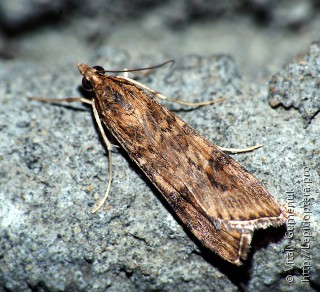Nomophila noctuella (Denis & Schiffermuller, 1775)

Taxonomy
class Insecta → subclass Pterygota → infraclass Neoptera → superorder Holometabola → order Lepidoptera → superfamily Pyraloidea → family Crambidae → subfamily Spilomelinae → genus Nomophila → species Nomophila noctuella
Species name(s)
Nomophila noctuella (Denis & Schiffermuller, 1775) = Pyralis hybridalis Hübner, 1796 = Nephopteryx indistinctalis Walker, 1863 = Botys helvolalis Maassen, 1890. [9, 10]
Rush Veneer.
urn:lsid:insecta.pro:taxonomy:9465
Expansion
This species marks on the maps: 6.
Zoogeographical regions
Palaearctic.
Russia regions
#1. Kaliningradsky; #2. Kolsky; #3. Karelsky; #4. Evropeisky Severo-Zapadny; #7. Evropeisky yuzhno-tayozhny; #8. Evropeisky Tsentralny; #9. Evropeisky Tsentralno-Chernozyomny; #10. Sredne-Volzhsky; #11. Volgo-Donsky; #12. Nizhnevolzhsky; #13. Zapadno-Kavkazsky; #14. Vostochno-Kavkazsky; #17. Yuzhno-Uralsky; #20. Yuzhno-Zapadnosibirsky; #28. Zabaikalsky; #36. Sredne-Amursky; #37. Nizhne-Amursky; #38. Sakhalin; #39. Yuzhno-Kurilsky; #40. Primorsky.
Wingspan
25—32 mm.
Primary colors
Brown/Gray/Black.
Flight time
| January | February | March | April | May | June | July | August | September | October | November | December |
Over-wintering stage
Larva.

Detailed information with references
Distribution
- Albania, Austria, Belgium, Bulgaria, Great Britain, Hungary, Germany, Denmark, Greece, Ireland, Iceland, Spain, Italy, Corsica, Crete, Luxembourg, Malta, Netherlands, Norway, Poland, Portugal, Romania, Sardinia, Sicily, Slovakia, Turkey - European part, Finland, France, Czech Republic, Switzerland, Sweden, Estonia, Yugoslavia. [1].
- Austria, Azores, Albania, Baleares, Belgium, Bulgaria, Bosnia and Herzegovina, the British Isles, France, Germany, Gibraltar, Greece (mainland), Denmark (mainland), Ireland, Iceland, Spain (mainland), Italy (mainland), the Canary Islands, Corsica, Crete, Latvia, Liechtenstein, Lithuania,Luxembourg, Madeira, Macedonia, Malta, Moldova, Netherlands, Norway (mainland), the Channel Islands, the Savage Islands, Poland, Portugal (mainland), Romania, Russia, Sardinia, Sicily, Slovakia, Slovenia, Turkey (European part) Faroe Islands, Finland, France (mainland), Croatia, Czech Republic, Switzerland,Sweden, Estonia, Yugoslavia. [10].
- Regions of the Russian Federation: the Volga-Don, East Caucasus, the European North-West, the European Central Black Earth, the European Central European South taiga, Transbaikalia, Western Caucasus, Kaliningrad, Karelia, Kola, Nizhne-Amur, Lower Volga, Primorye, Sakhalin , Mid-Amur, Mid-Volzhsky,South West Siberian Yuzhno-Kuril, South Ural. [3].
- In the Far East, everywhere except the Far North. [113].
Imago Habitus and Differences from alike species
- Swipe KRL. 25-32 mm. Antennae of both sexes simple, filamentous .. labial palps are long, directed obliquely upwards, two-color: white and brown, gustoopushёnnye. The maxillary palps short, brown. Proboscis and eyes are. The forehead, crown and nape in smooth brown bristles.
Trans.KRL long, narrow, reddish-brown, with the same color 2 large cross-oblong patches, trimmed with chocolate-brown scales, arranged at the end and at the beginning of the middle of the cell, and some chocolate-brown spots along the costal margin. Fringe two-color: brown and cream. The rear. KRL.light brown, without pattern. Fringe cream.
In the lane. KRL. R2 vein parallel to the common stem 3 n4; veins M2 and M3 are separate. On the back. KRL. veins M2 and M3 depart otsredinnoy separate cells, but their bases close together. [113].
Imago lifespan
- Moth flight is observed from late April to September. Most mass flight occurs in August and September. [113].
General info about Larva
- After oviposition, 3-15 days appear caterpillars which is first skeletonizing leaves on the one hand, then the nibble holes in them. Caterpillars of older building with the help of silk threads at the bottom of the tube plant, covered with leaves and soil particles. They live, pulling pieces of leaves. [113].
Larva food plants / other food objects
- Trifolium, Medicago, Polygonum, Triticum, Poa, Vaccinium. [28].
- Polyphagous pest. Caterpillars on clover, alfalfa, corn, wheat, buckwheat, wild strawberry. [113].
Larva lifespan
- Caterpillar stage lasts 15-40 days. After finishing the development, the caterpillars cocoon made between listmi on the ground, under rocks, where winter and next spring pupate. [113].
Egg
- After copulation the female lays eggs up to 120-350 pieces. the leaves, stalks or inflorescences in groups or singly. [113].
Overwintering stage
- Adult caterpillars winter in cocoons, sometimes wintering butterflies part of the last generation. [113].
Authors
Initial species uploading to the site: Peter Khramov.
Photos:
Vlad Proklov, Vitaly Gumenuk. Text data: Peter Khramov, Yuri Semejkin.
The species characteristics formalization: Peter Khramov, Sergei Kotov.
References
- [1] O. Karsholt, J. Razowski (eds.), 1996. The Lepidoptera of Europe: a distributional checklist
- [3] Каталог чешуекрылых (Lepidoptera) России. Под ред. С. Ю. Синёва. СПб.; М.: Товарищество научных изданий КМК, 2008
- [9] Tree of Life (funet.fi), 2012
- [10] de Jong, Y.S.D.M. (ed.) (2011) Fauna Europaea version 2.4 (faunaeur.org)
- [28] Moths and Butterflies of Europe and North Africa (leps.it), 2012
- [113] В.А. Кирпичникова Огнёвки (Lepidoptera, pyraloidea: pyralidae, crambidae) фауны Дальнего Востока России. Владивосток: Дальнаука, 2009:
Comments
Note: you should have a Insecta.pro account to upload new topics and comments. Please, create an account or log in to add comments
Nomophila noctuella photos
Other species Nomophila




































